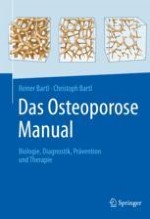2021 | OriginalPaper | Buchkapitel
23. Monitoring der medikamentösen Osteoporosetherapie
verfasst von : Reiner Bartl, Christoph Bartl
Erschienen in: Das Osteoporose Manual
Verlag: Springer Berlin Heidelberg
Zusammenfassung
-
Langzeittherapien chronischer Erkrankungen bedürfen regelmäßiger Kontrollen, Anpassungen der Therapie und Früherkennung möglicher Nebenwirkungen.
-
Die empfohlene Dauer einer Therapie mit Bisphosphonaten (BP) oder Denosumab beträgt je nach Schweregrad der Osteoporose mindestens 3–5 Jahre und sollte individuell fortgesetzt werden. Der Therapiezeitraum von 1 Jahr sollte nicht unterschritten werden.
-
Der Therapieerfolg wird kurzfristig (Monate) mit der Bestimmung von Knochenumbaumarkern und langfristig (Jahre) mit der DXA-Messung überprüft.
-
Heute wird von Osteoporoseexperten weltweit nach 5 Jahren Therapie mit einem antiresorptiven Medikament eine 1-jährige Pause („drug holiday“) empfohlen.
-
Therapieversager sind selten und bedürfen einer Überprüfung der Diagnose (z. B. sekundäre Ursachen), des Therapieschemas (z. B. störende Begleitmedikamente) und der Einnahmetreue (Compliance) des Patienten.
-
Nach Absetzen von Denosumab wird die Fortführung der Therapie nach einer Pause von einigen Monaten mit einem BP empfohlen, um den raschen Verlust der gewonnenen Knochendichte zu unterbinden.
-
Anabole Substanzen sollten möglichst vor potenten antiresorptiven Substanzen zum Einsatz kommen.
-
Die Zahl an Patienten, die in Europa ein Antiosteoporotikum erhielten, stieg bis 2008 kontinuierlich an und fiel dann nach einem Plateau stetig ab. Diese Behandlungslücke („osteoporosis treatment gap“) scheint sich derzeit in den USA und in Europa zu verschlimmern, mit der Folge, dass osteoporotische Frakturen und ihre Behandlungskosten für die Gesellschaft deutlich zunehmen.














